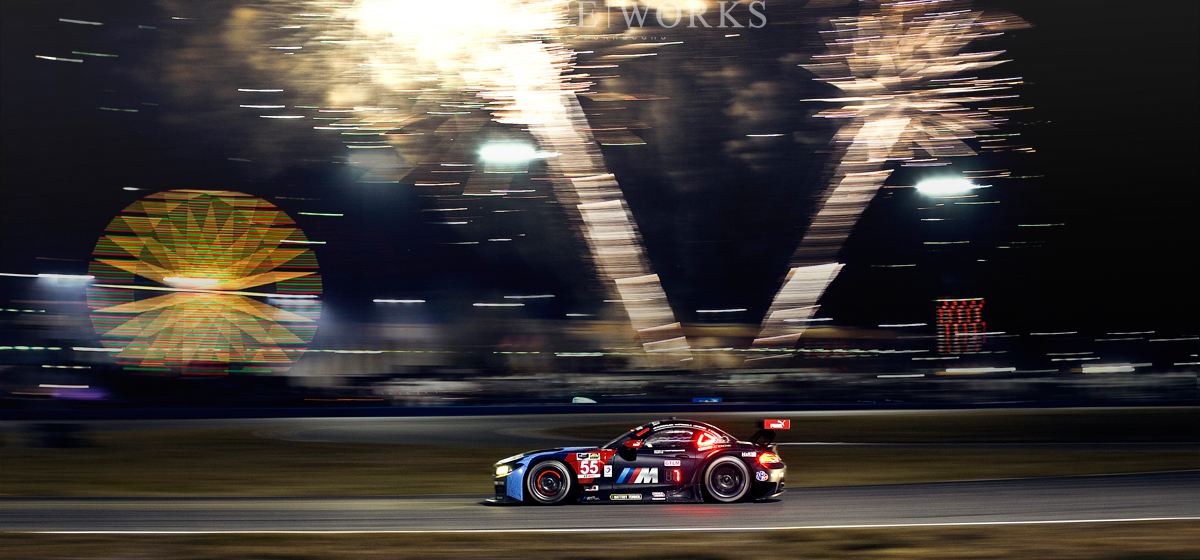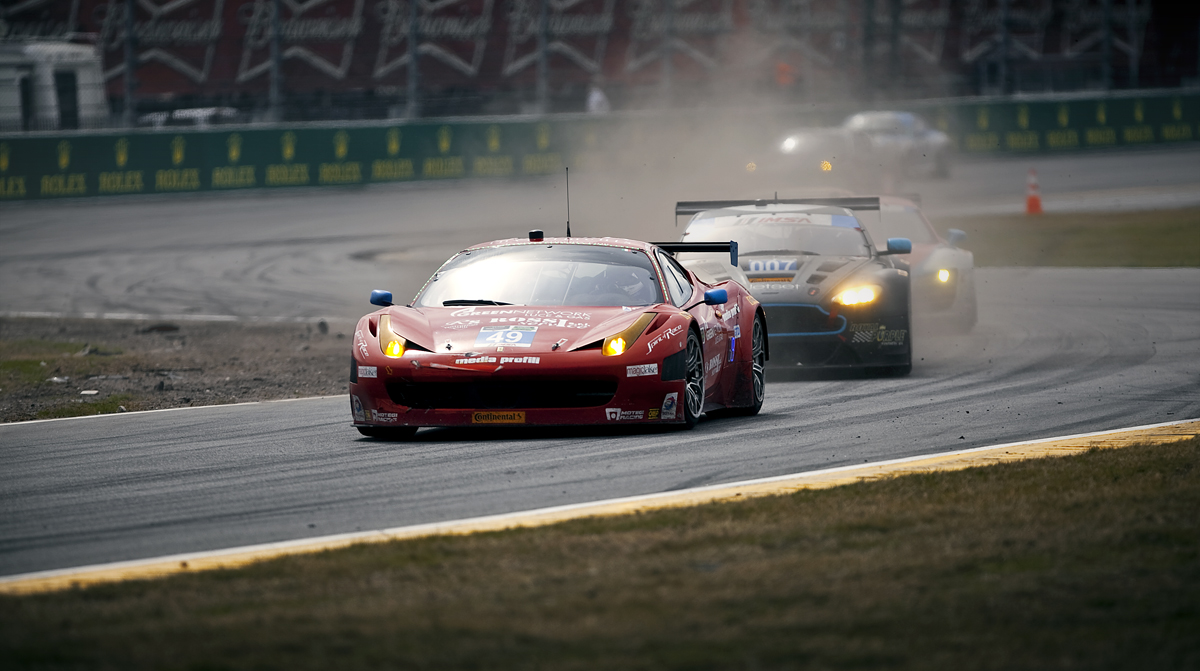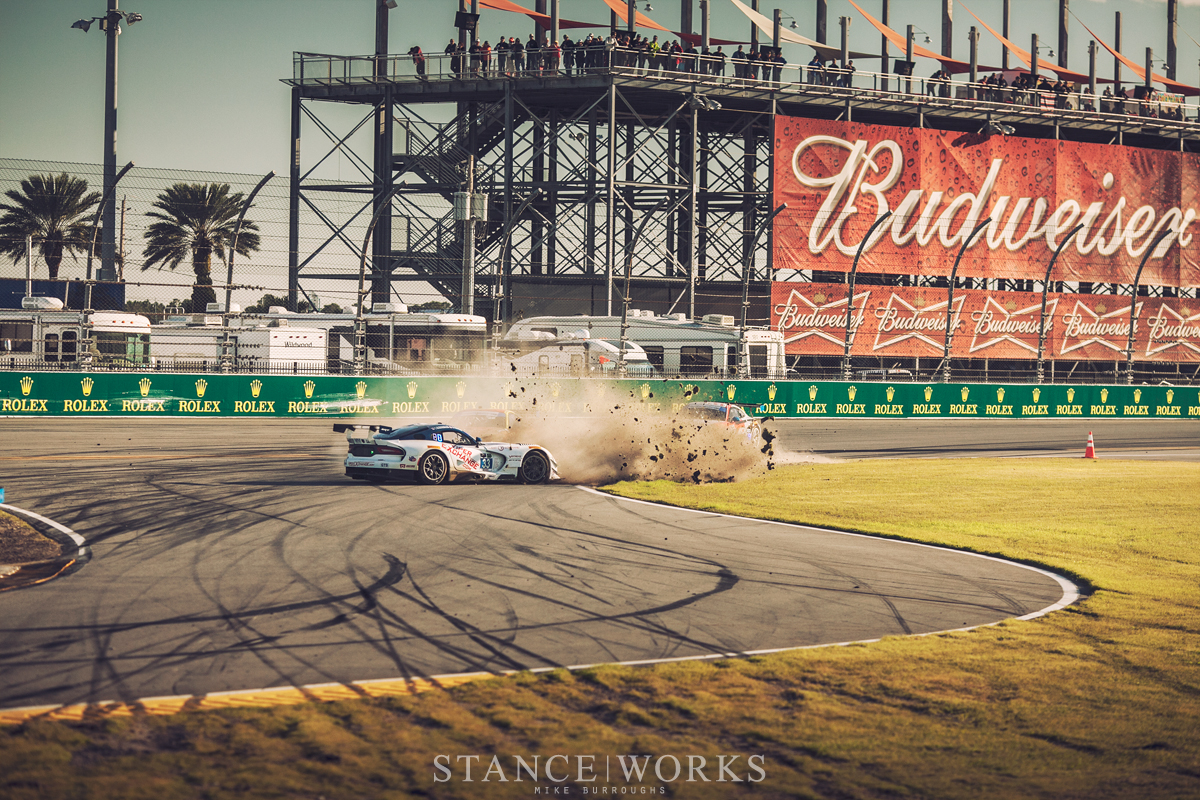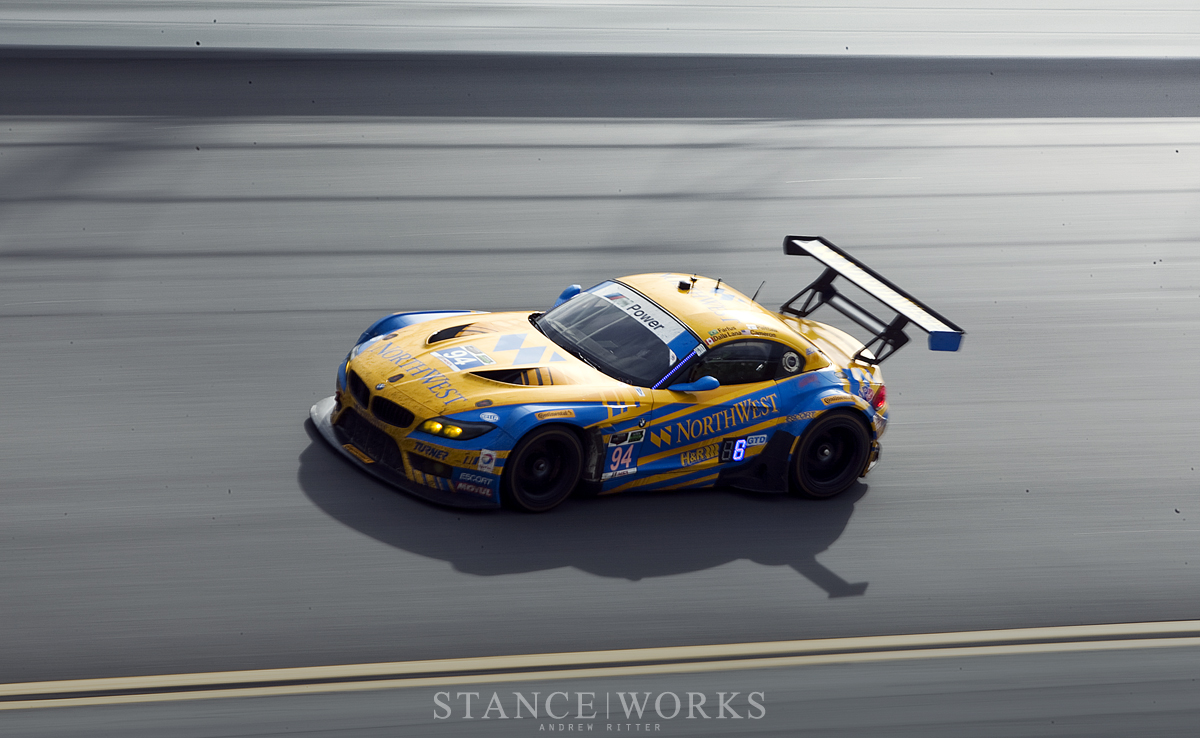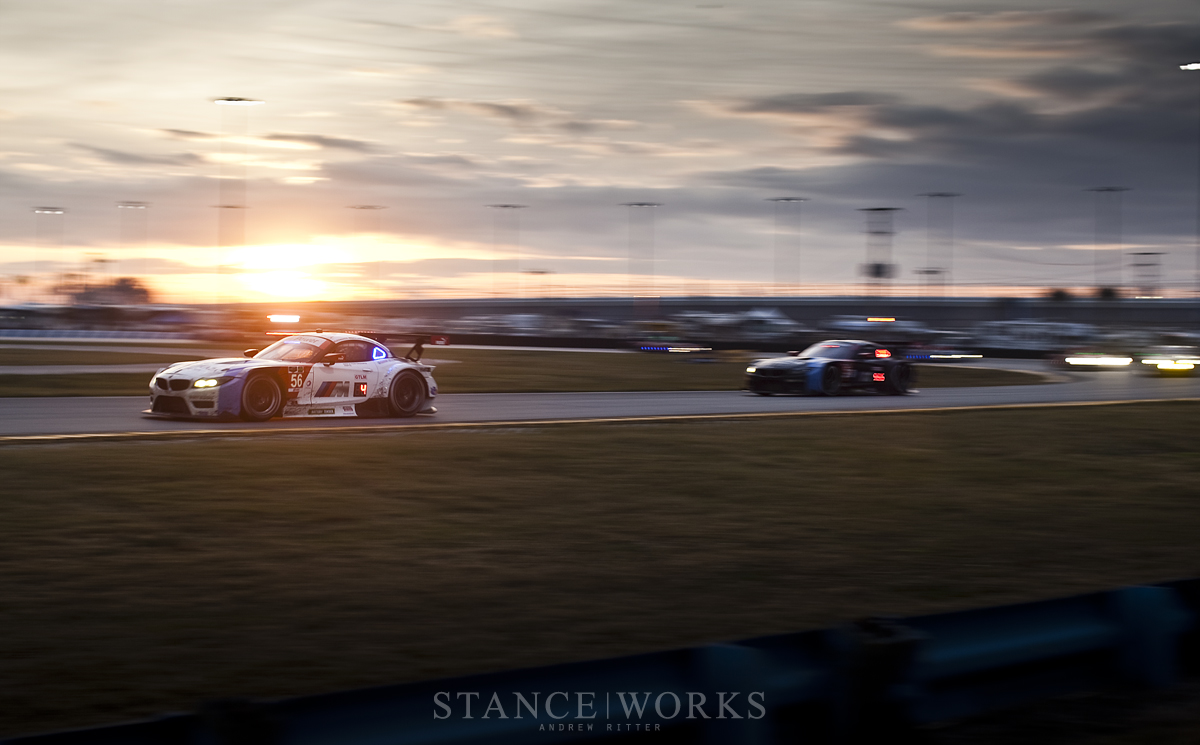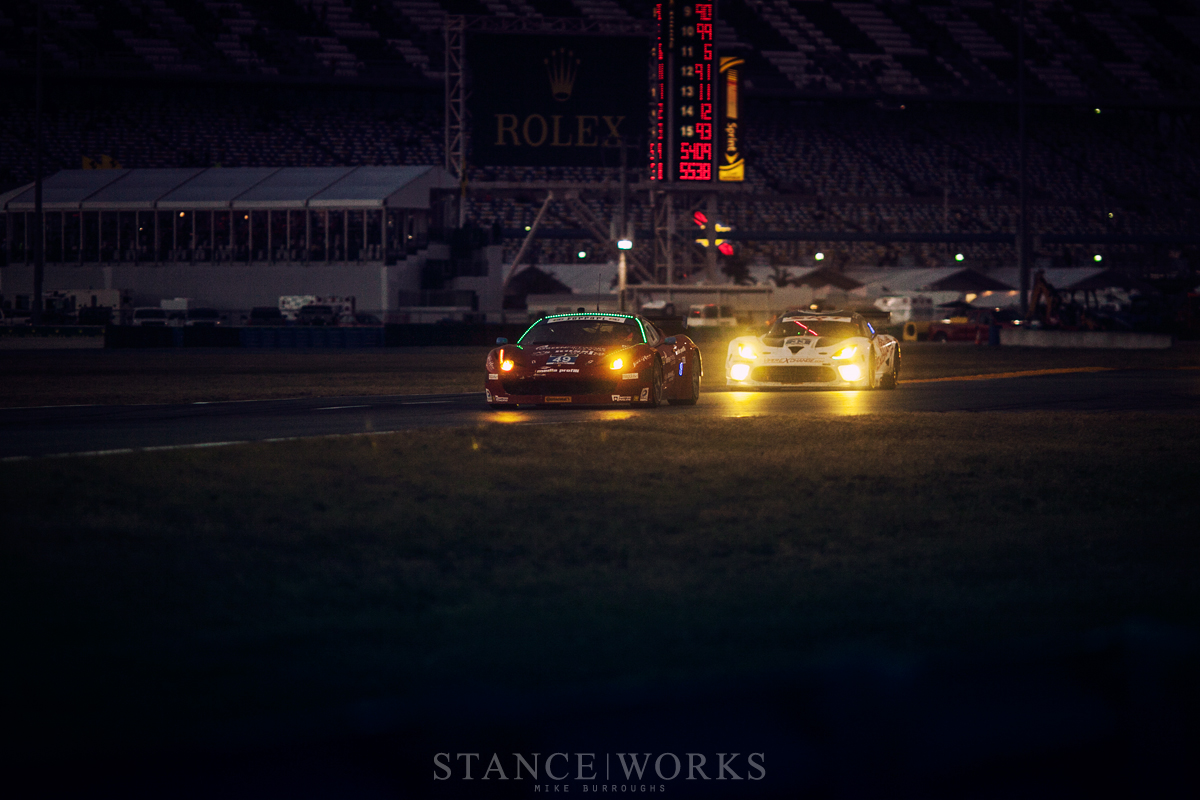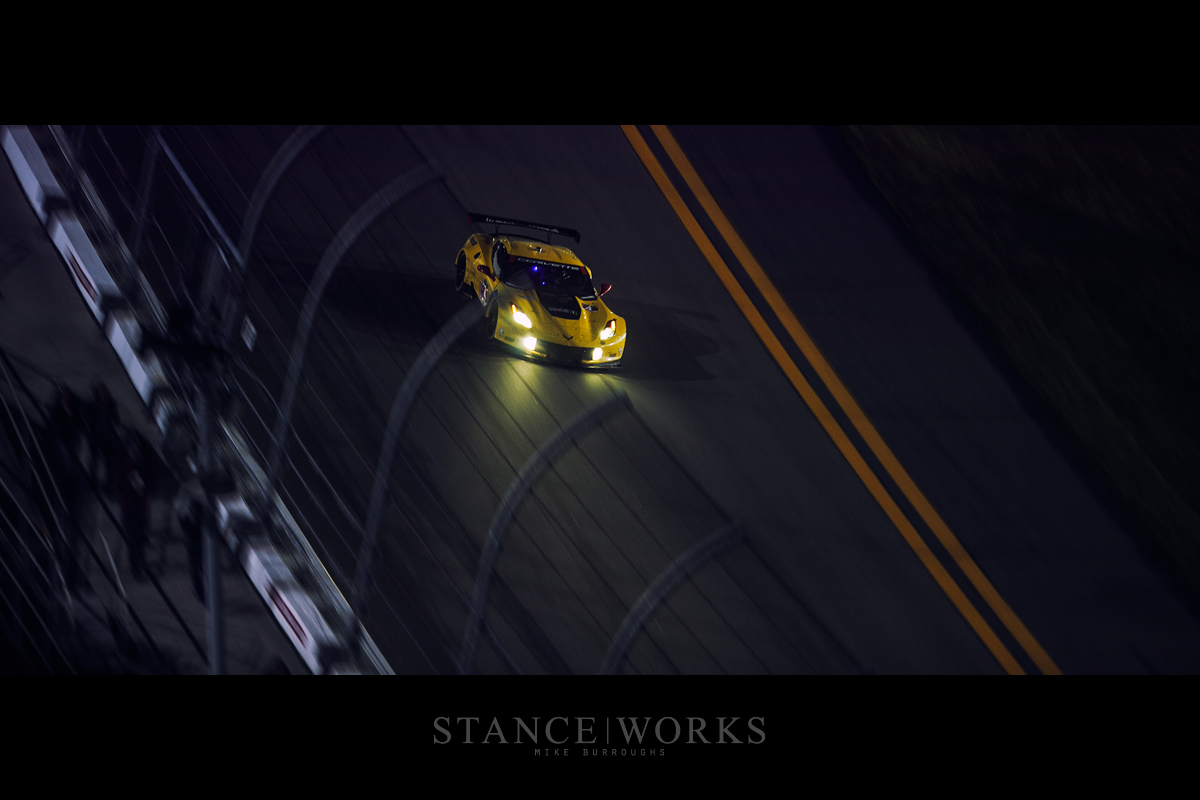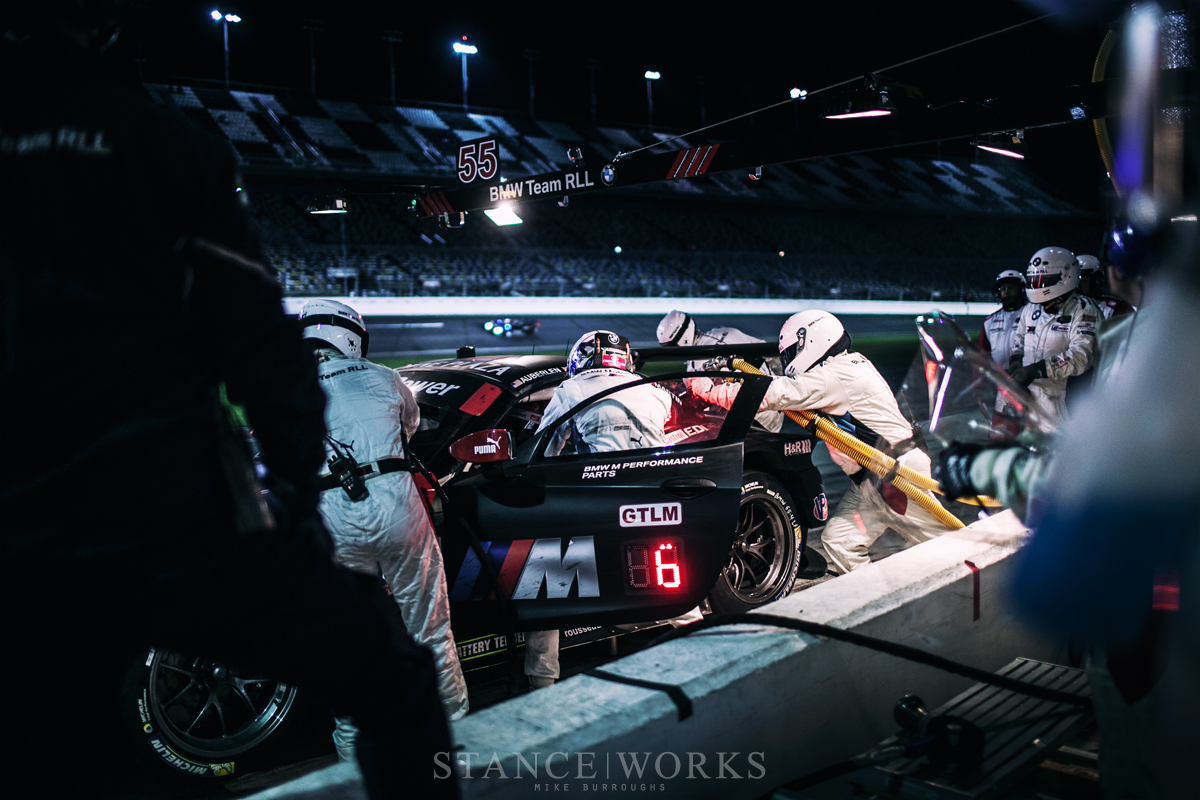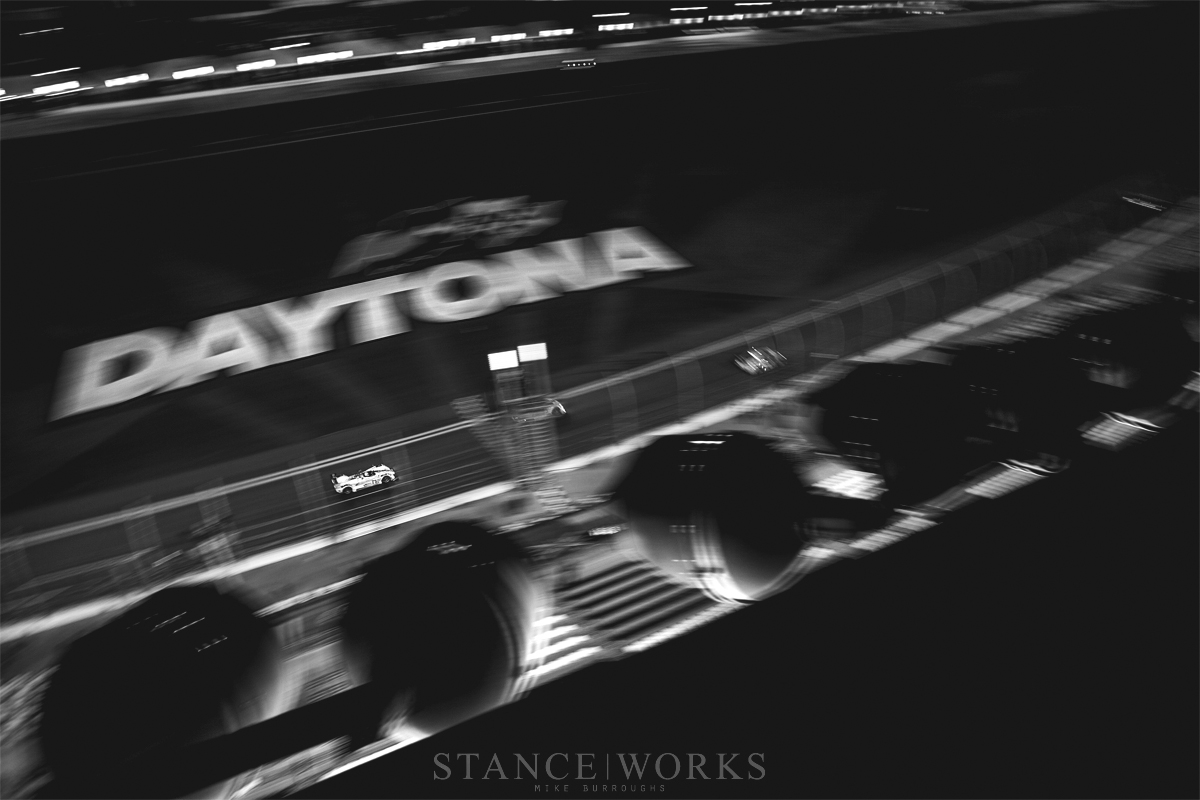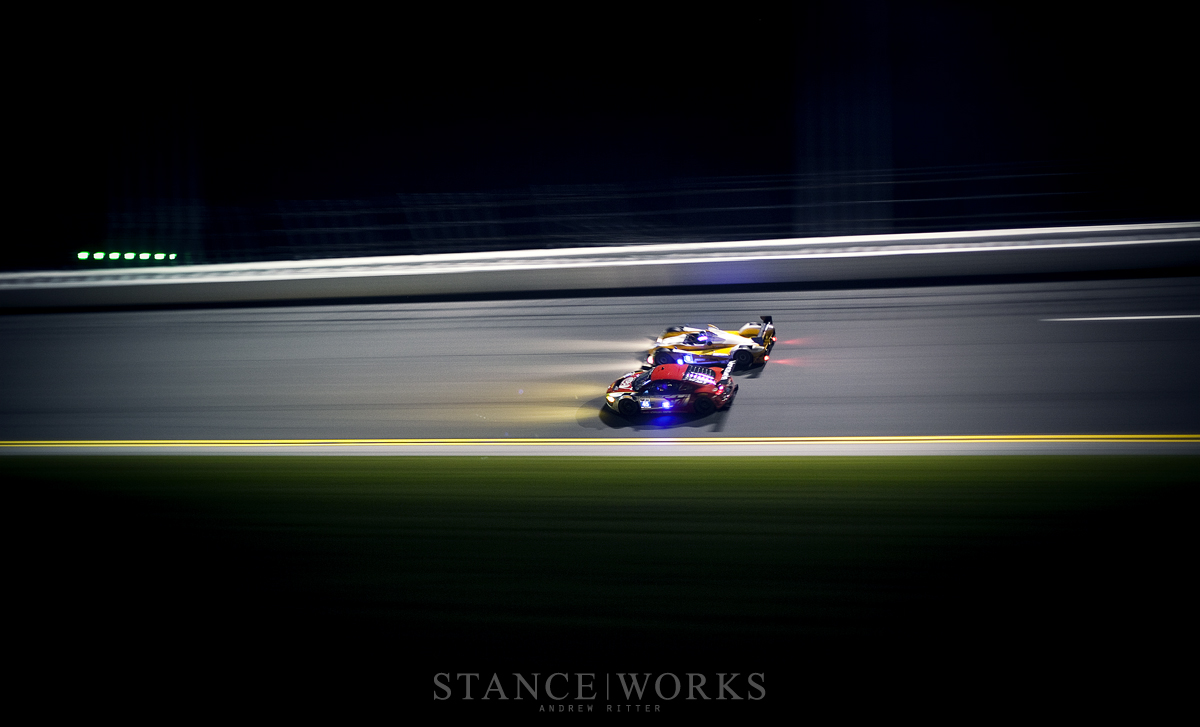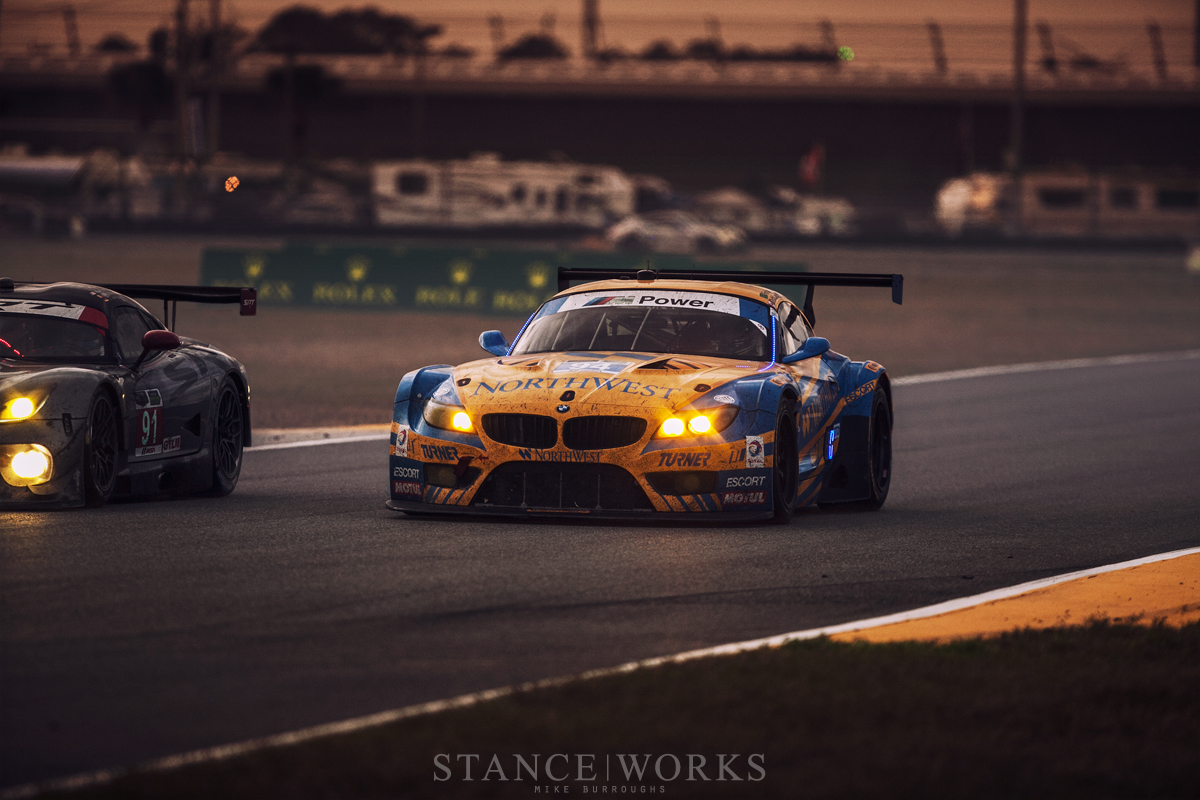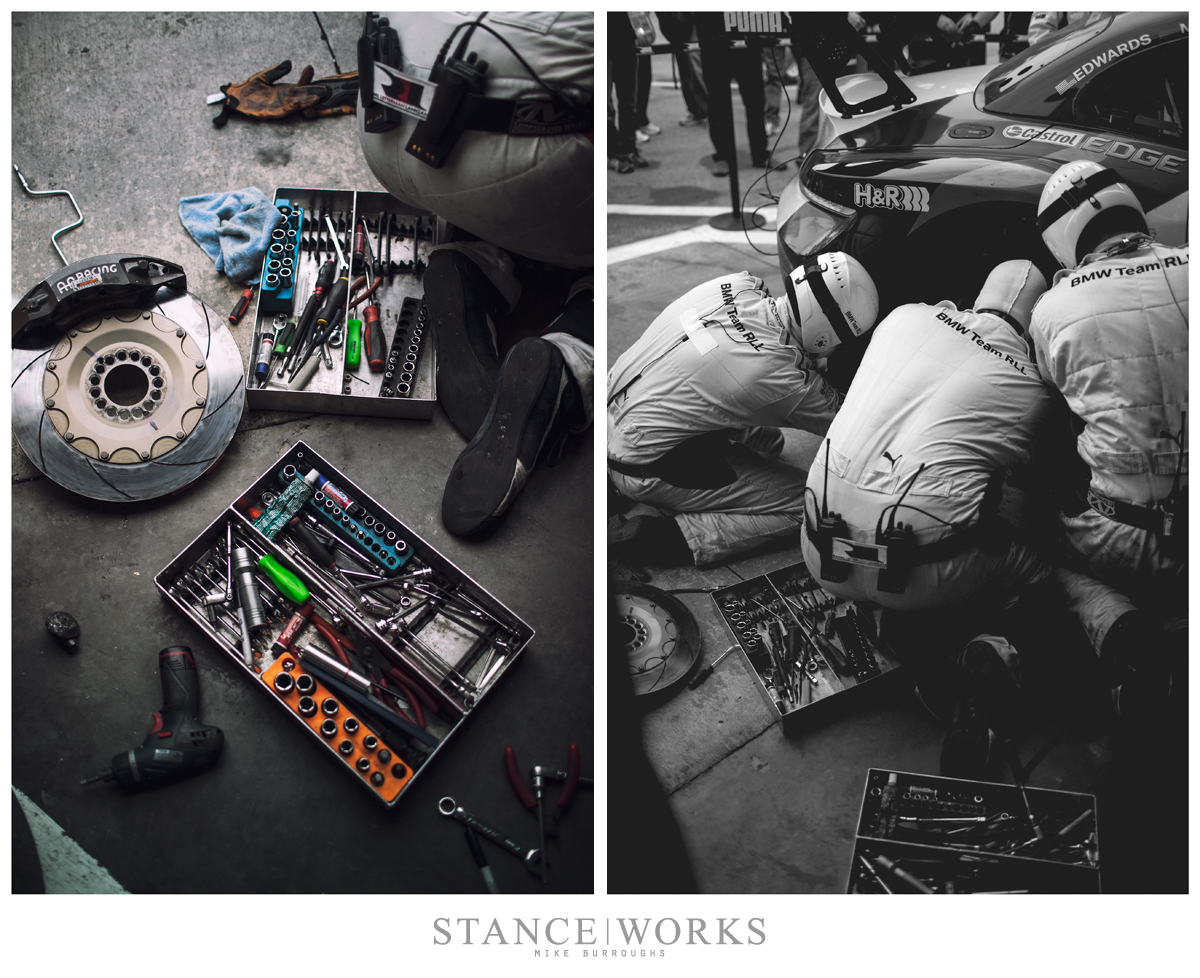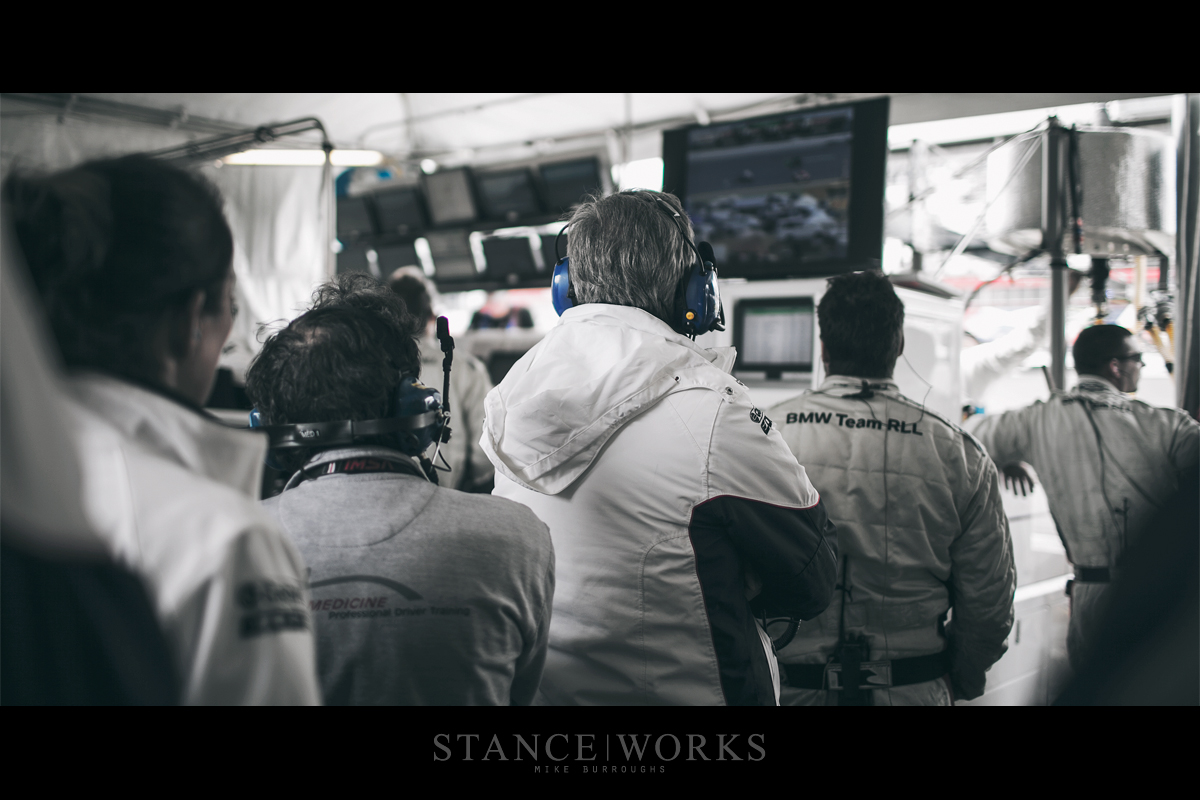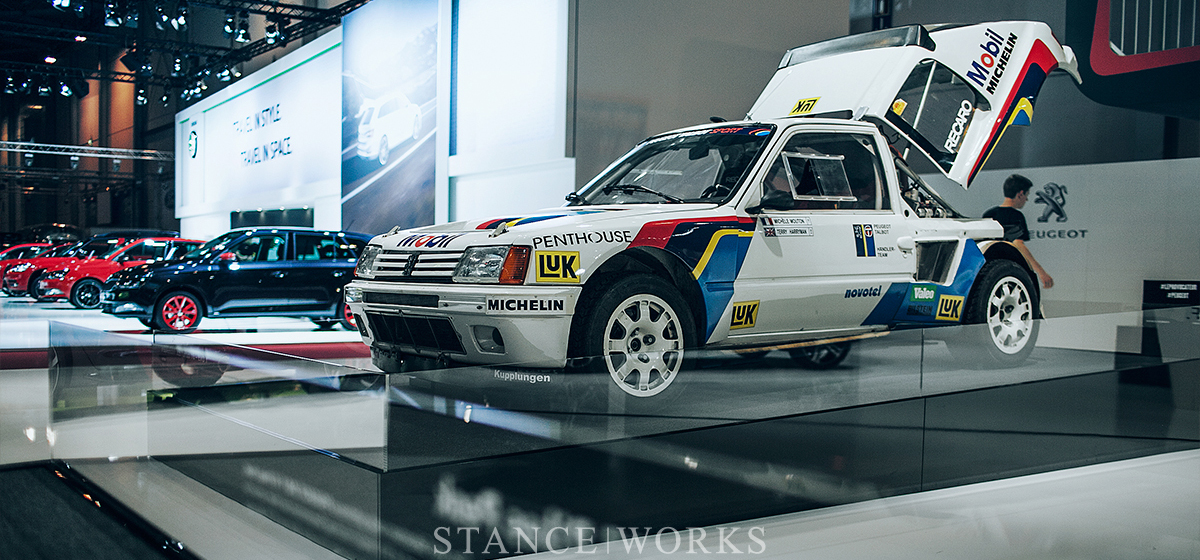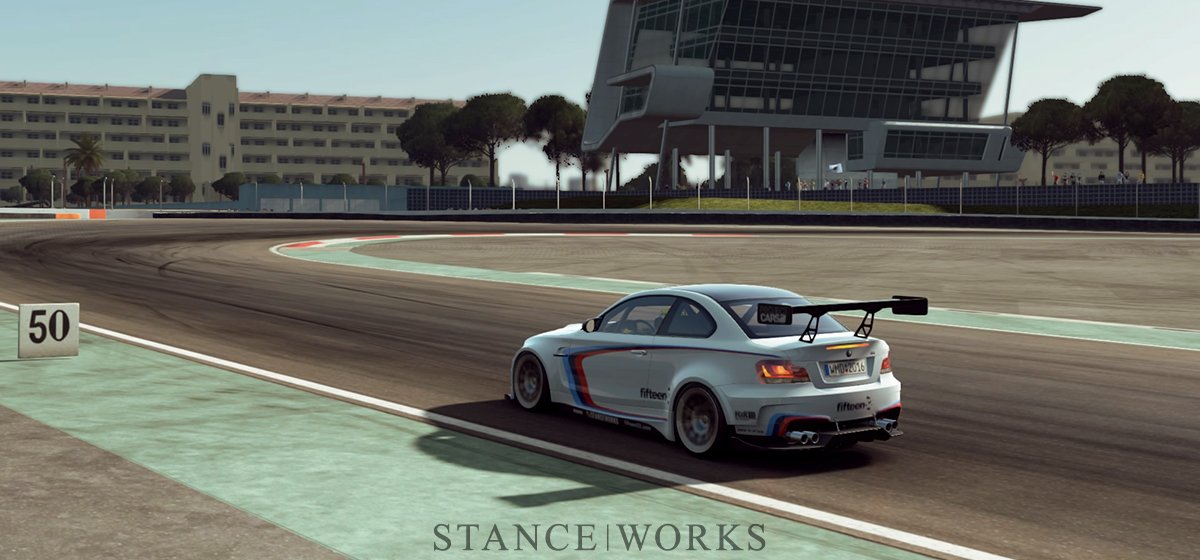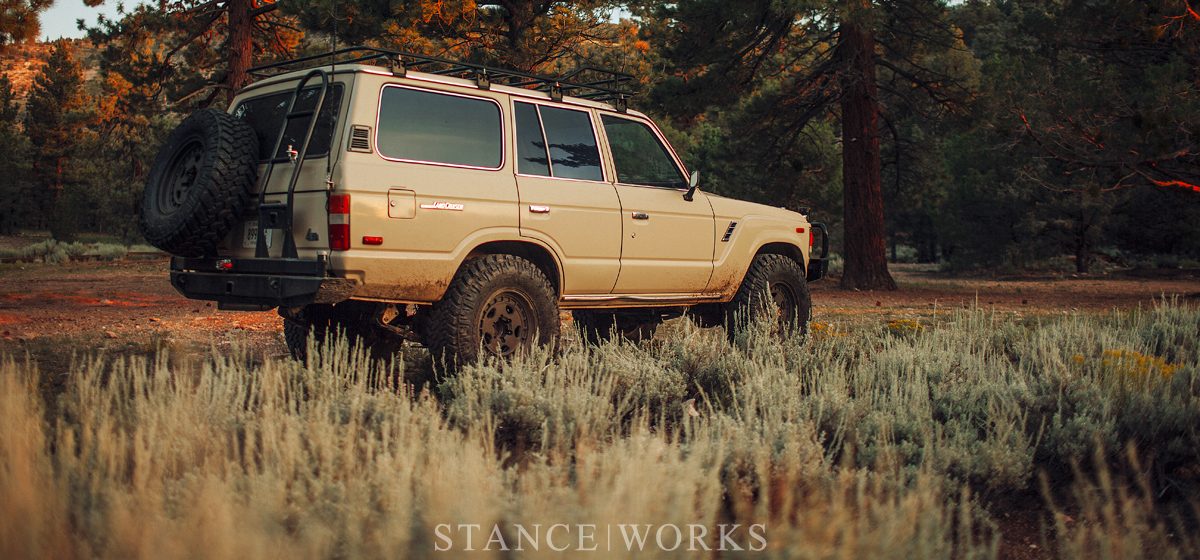The 24 Hours of Daytona has long been regarded as one of the most challenging races in the world. Titled the Rolex 24 for the past 23 years, it stands as a leg in the Triple Crown of endurance racing, followed by the 12 Hours of Sebring and the 24 Hours of Le Mans. Together, these races push cars, and teams to their absolute limits of durability and sanity. Andrew and I flew to Florida join in; to push ourselves to the limit in capturing our first-ever 24-hour race.
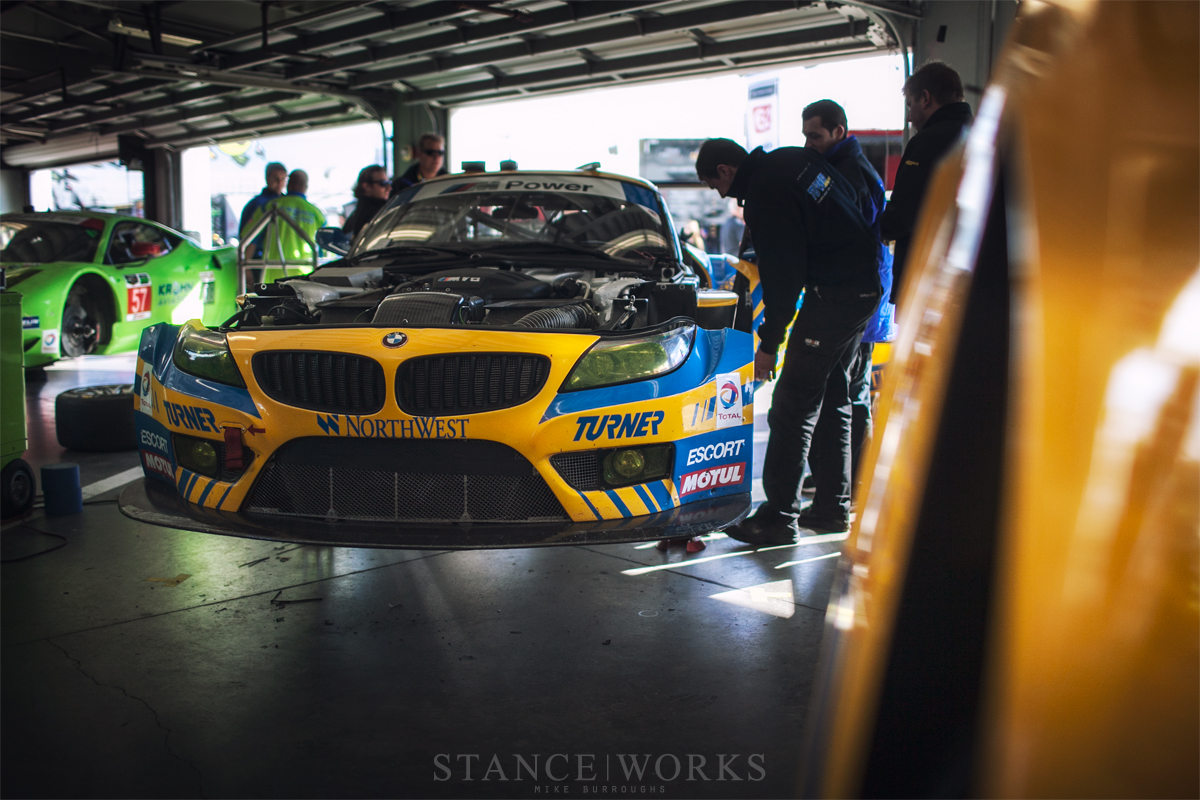
The 24-hour duration only represents the length of the race itself. For many, the test of endurance lasts far longer, including ourselves. Raceday began with a 5:00am alarm. Our typical hotel-morning rise-and-shower routine was followed by an early arrival at the track, just before the sun began to light the sky. Each car was in its designated garage bay, a majority of them were aesthetically disassembled to some degree – others, completely torn apart for the race to come. As the clock hit 8:00am, it meant just six hours until the race began.
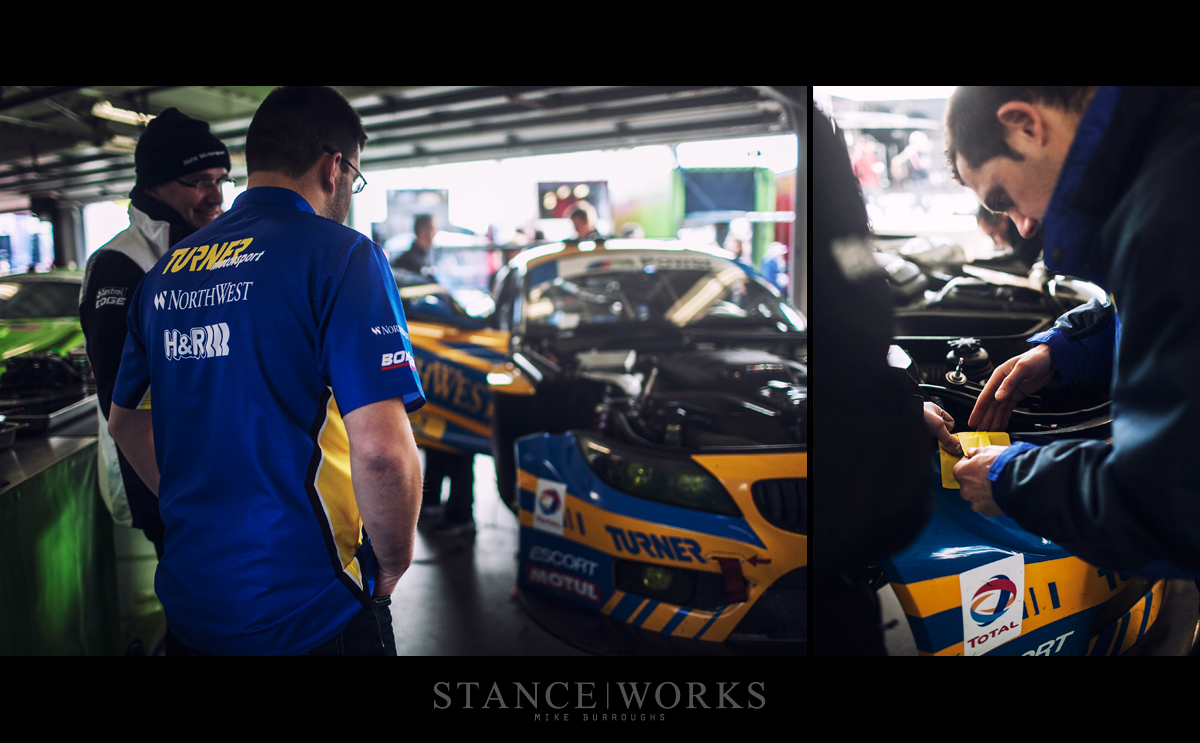
Our first stop among the garages was a visit to our friends at Turner Motorsport. We were eager to see their new GTD Z4, traced in their 1995 Renault BTCC-inspired vibrant blue-and-yellow livery. The Rolex 24 marks the first race for Turner in their new Z4, which arrived from Europe back in October. We looked on as the team readied the car, and admired the lines that the GT3’s kit offers in comparison to Team RLL’s GTE counterpart. From kidney to diffuser, each team checked and re-checked their cars, ensuring that each one was ready for the daunting task that lie ahead. The car’s durability and longevity are just as important as its driver’s – if the car is unable to bear the weight of racing for 24 hours straight, its chances of winning quickly dwindle.
After Turner’s garage, we made our way over to see our friends at Team RLL. The black and white sisters are back again – this time with minor changes in preparation to take on the GTLM class. The RLL crew was hard at work, just as Turner was, prepping the cars for the race as it sped toward them. Time before the race was being siphoned at an alarming rate, and we watched as the crew members of Team RLL made their way to the starting grid.
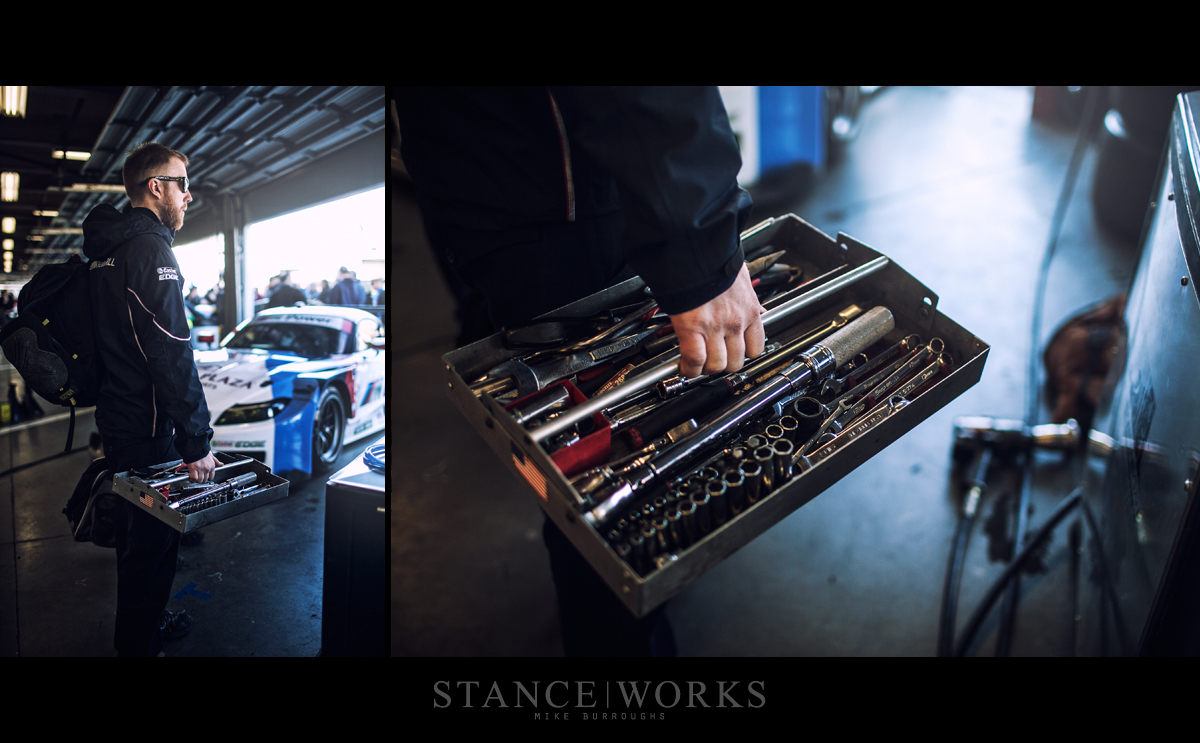
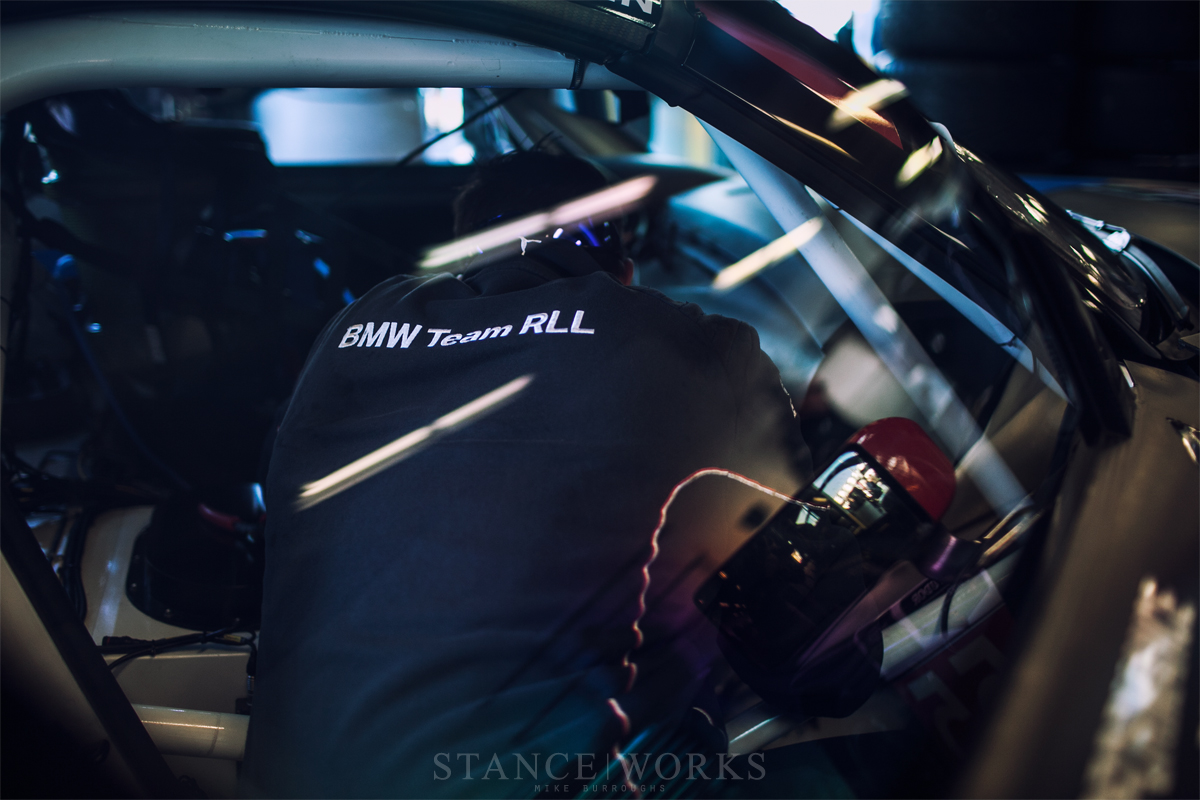
On the grid, a jaw-dropping count of 67 cars lined up for the start of the race. The 52nd Annual 24 Hours of Daytona marks the first race of the all-new Tudor United SportsCar Championship, which has brought together Grand Am and IMSA, and their two primary series, the Rolex Sports Car Series and the American Le Mans Series, respectively. The result is four classes of cars on the tarmac at Daytona. The top-tier class is that of the Daytona Prototypes, followed by the Prototype Challenge cars, which are easily distinguished by their overall aesthetics. The two classes that garner our interests, however, are GTLM and GTD.
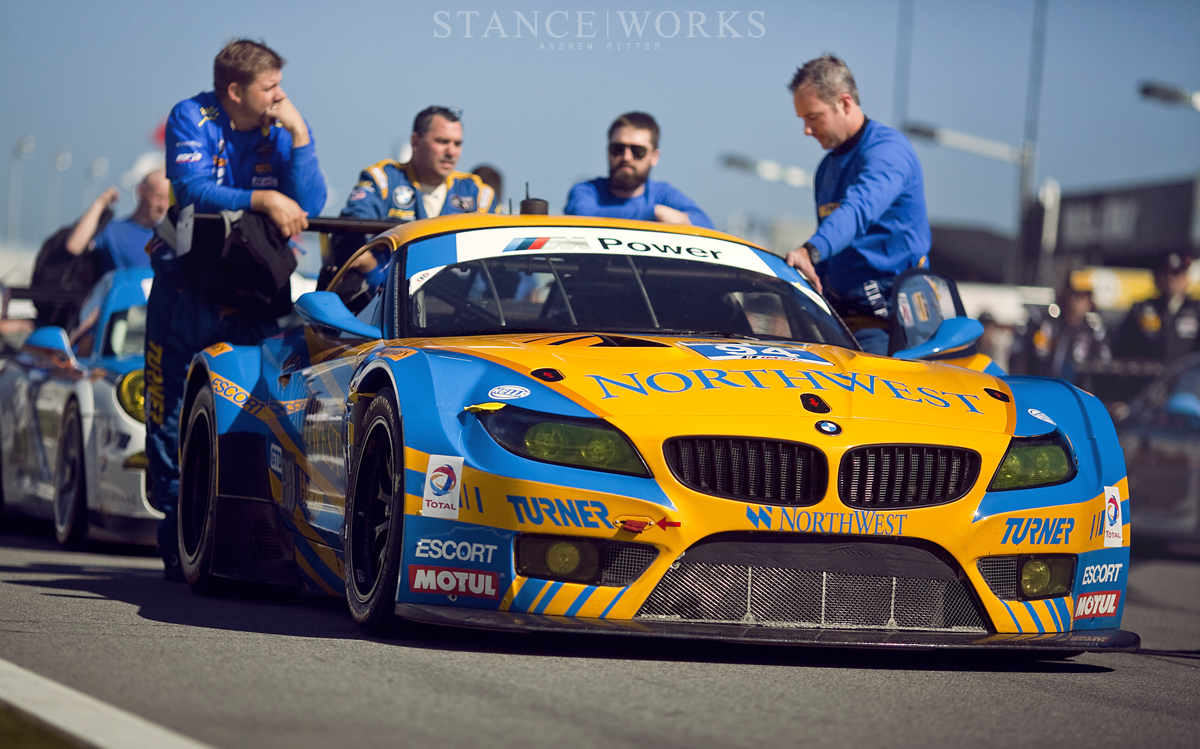
GTLM is what remains, and is very close to the GT class of the ALMS, whereas the GT Daytona (GTD) class is built upon the remains of Grand Am, ALMS’s GTC class, and FIA GT3 cars. The differences are minor, with the main areas of change relegated to aerodynamics, and a roughly 50 horsepower advantage given to the GTLM class. The GTD’s weight specifications tally in at a 65-pound lighter minimum weight, and lastly, the fuel differences between the two are IMSA E85C and E10, respectively. While the differences are present, both GT classes fight head-t0-head for real estate on the asphalt.
Shortly after 2:00pm, the Audi R8 pace car made it’s final lap and the 52nd Annual Rolex 24 was underway. A field of clean, beautiful race cars made all but a complete lap before the carnage of motorsports began. Within a few laps of the race, the chaos affected our own – the #55 car, with Auberlen, Muller, Rahal, and Priaulx behind the wheel, was sent off in to the grass as a Prototype Challenge car spun heading into Turn #2. Porsche’s pair of 991s snuck past to gain an early head start on the race.
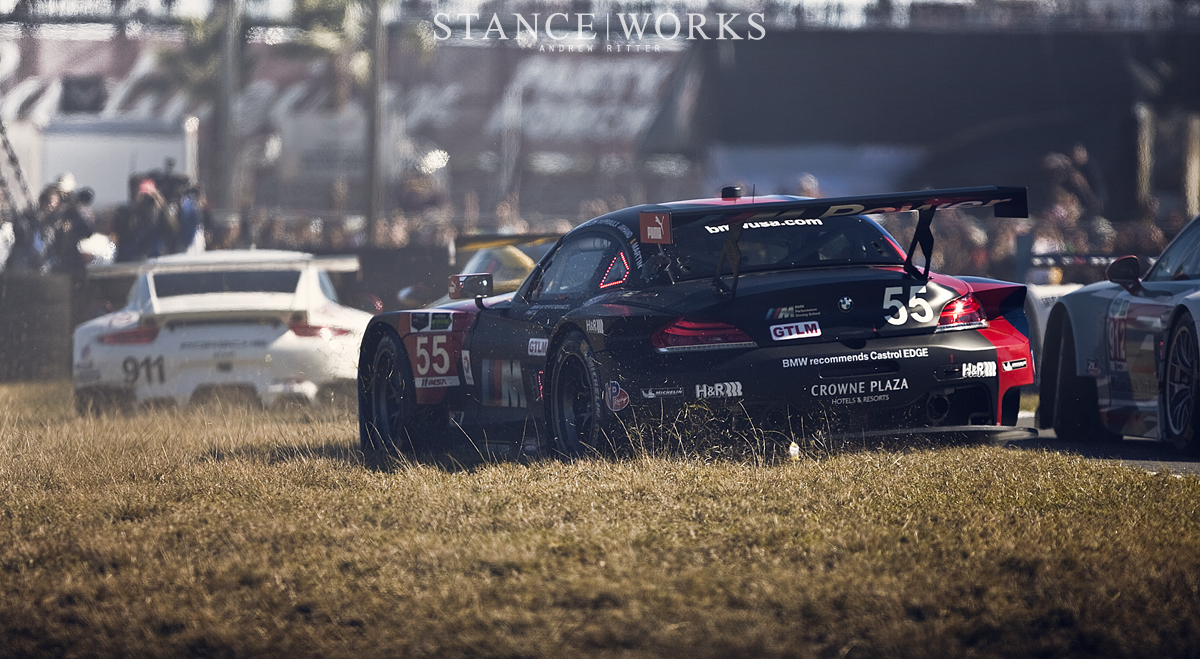
New to the field of GT cars this season is Corvette’s all-new C7.R, which, given Corvette’s track record the past two seasons, we feared would make for some very serious competition… and that, they did. The almost absurdly wide yellow thunderous Detroit coupes pounded down the banks of Daytona, and put the hurt on the rest of the GTLM and GTD field.
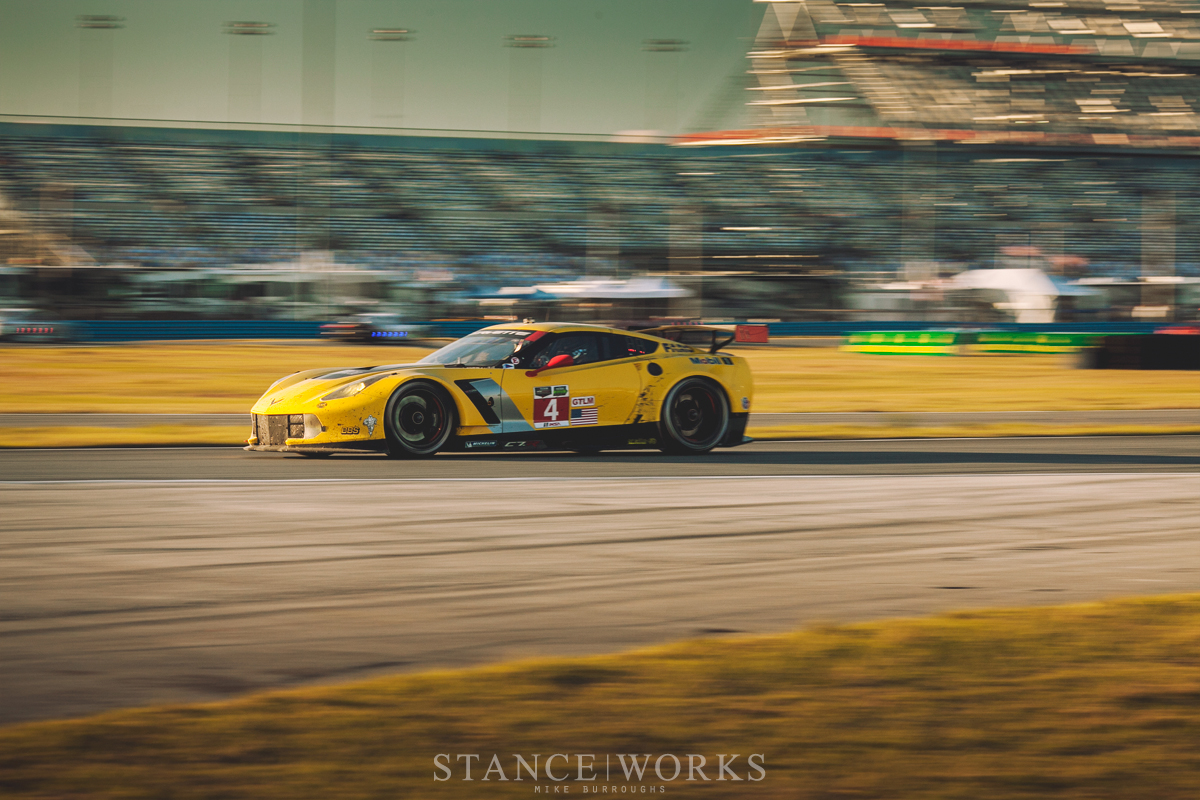
The hours continued to tick by as Andrew and I slowly and methodically worked our way around the track. The chicane on the back straight proved to be one of the best locations of the race for intense action. In the 20 minute span I photographed there, I watched as the Viper Exchange SRT spun violently off course, followed by the Krohn Ferrari 458, an Aston, Turner’s Z4, and then, in perfect unison, another pair of 458s. The corner was a dangerous one, and as the Turner Z4 screamed towards the infield wall, I worried that it would be an early end of the race for our friends in blue. Yet the car stopped just in time, just a few feet from the wall. In no time, the GTD Z4 was back on course and chasing down the opposition.
About four hours after the race began, we settled in as the sun set and the temperature dropped. The Team RLL Z4s moved up and down in position, hovering between holding 3rd and 4th, or 5th and 6th, depending on how Corvette’s new pair of cars was doing. Porsche’s 2014 campaign says that this is the year of their return to motorsport, which includes Tudor and Le Mans. They made their presence an intimidating one right from the start – the pair of GTLM 991s had been holding first and second place for nearly the entire race thus far.
The colors of the sky grew darker and more purple in color, until the glowing yellow lights of the GT classes stood in perfect contrast to the bright whites of the prototype cars. Our shutter speeds grew longer and longer as panning shots grew tougher and tougher in our mission to capture the true essence and movement of the race cars at Daytona. We threw on extra layers and gloves in order to stay warm as we spent the night trackside.
At 8:57pm, the annual fireworks display went off, giving us one last display of enthusiasm before the crowd slowly dissipated, and the campers slowly put themselves to sleep. As the sparks fell from the sky and dimmed into nothingness, we set in for the long haul.
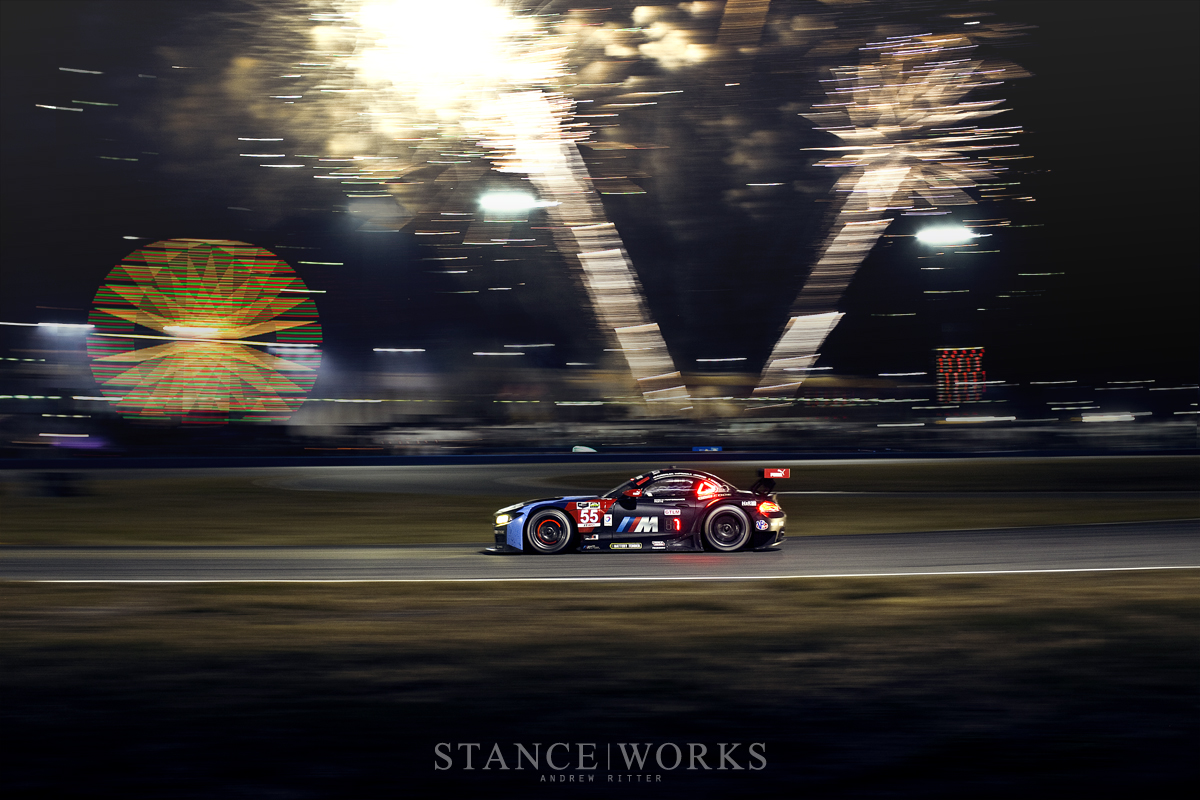
I paid a visit to the Team RLL pits, where the crew’s efforts were divided. The #55 and #56s cars were on constant analysis, ensuring that the driver was continuously comfortable, and that the car was as free from issues as possible. The fluorescents glowed against the dark sky, and surrounded on all sides, it was a safe-haven from the wind of the brisk night temperatures.
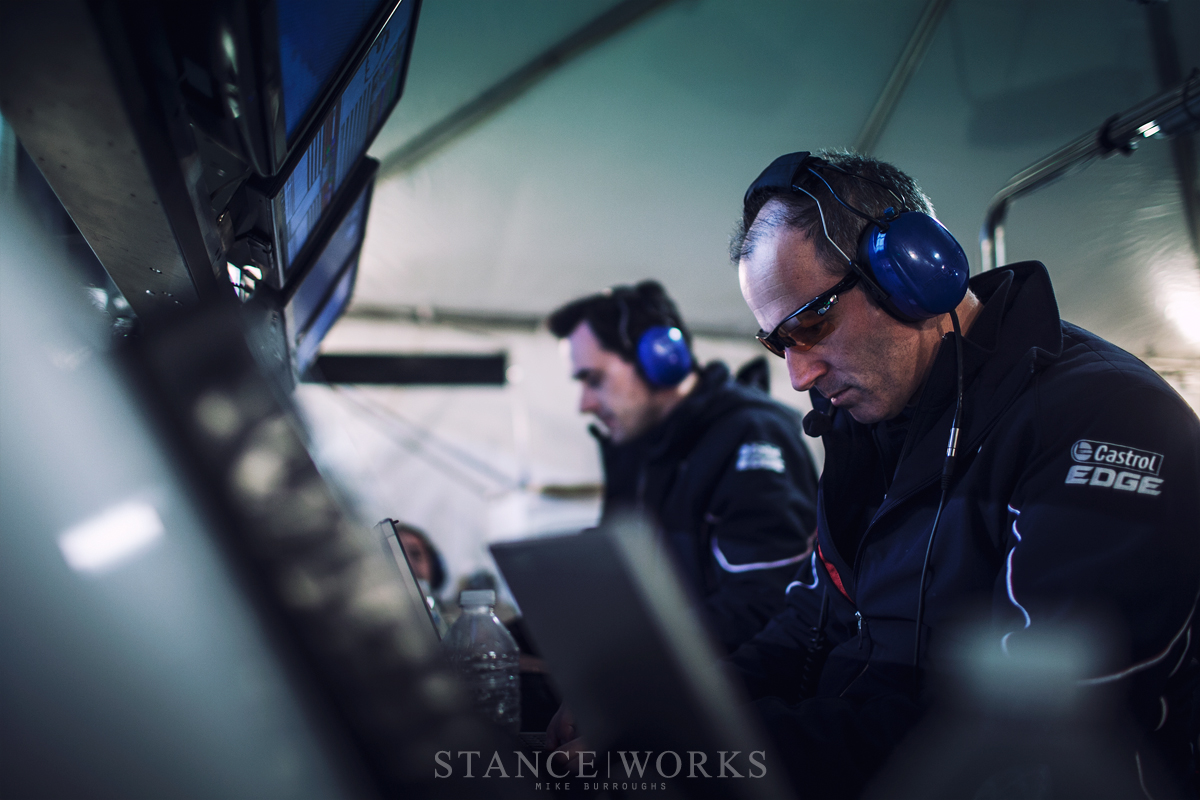
For many of the crew, the cold night played out as a waiting game. Eyelids grew heavy as the clock ticked between pitstops. Some watched as the cars flew by; the distinct sounds of each class provided clues of the approaching cars before they came barreling down towards pit lane into their line of sight. The bright Daytona lights illuminated each car as it came into view, only to disappear into the distance as it chased after Turn 1. For others, the time between pit stops offered a moment’s rest, and an escape from the sometimes monotonous burden that comes with such a test of endurance.
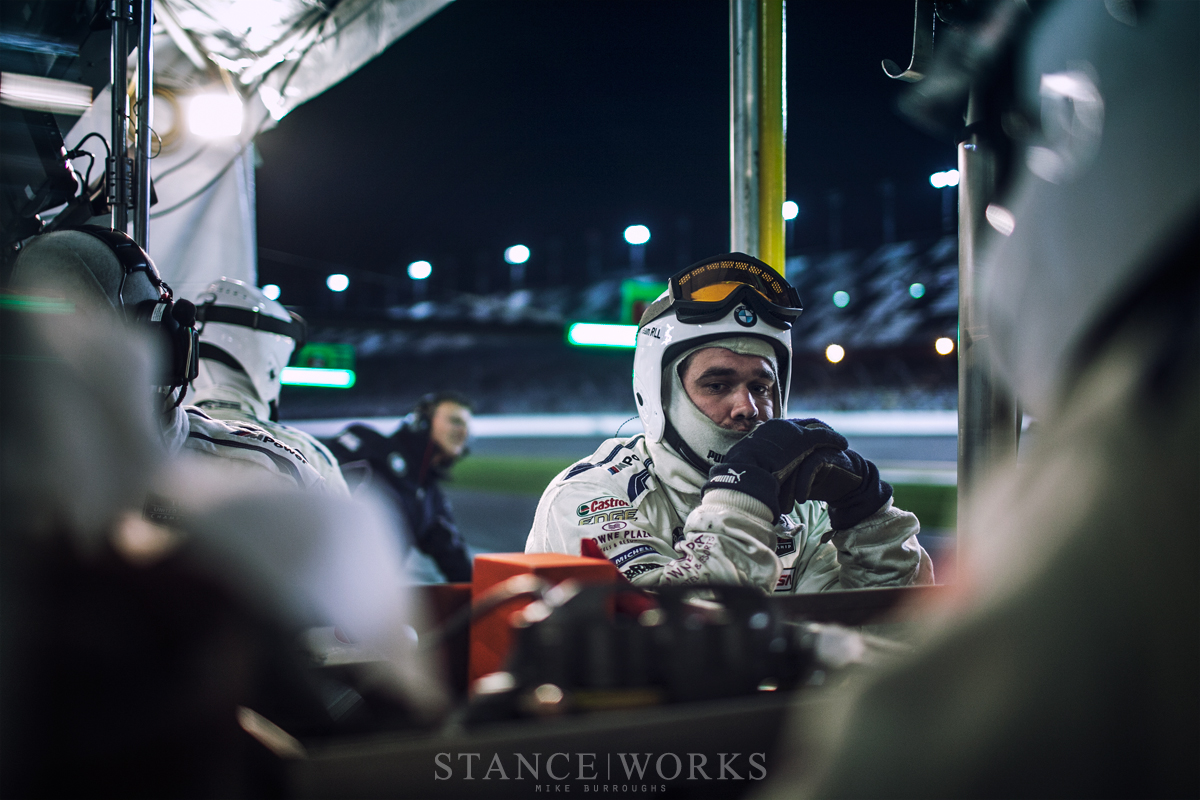
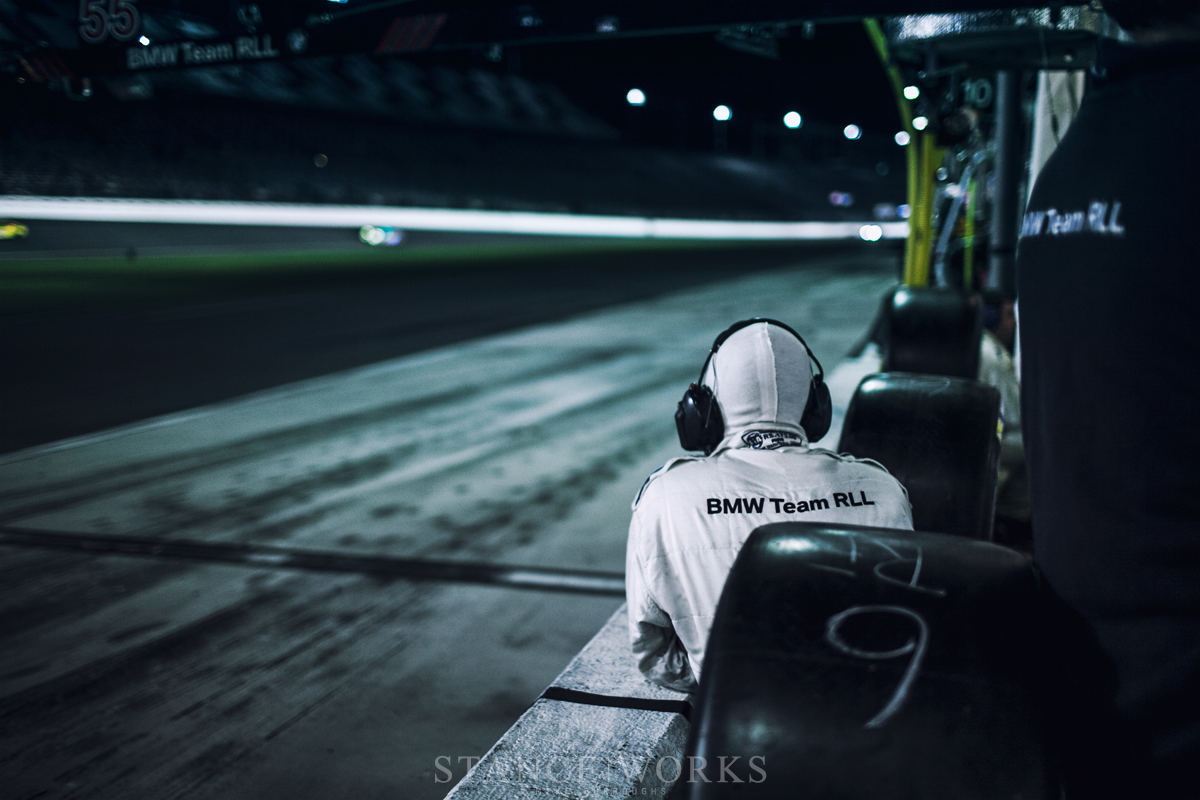
I watched as the pit crew for the #55 car readied, and before I knew it, the howl of the BMW V8 was in front of me. Pit rules have changed for the Tudor series, in contrast to ALMS’s take, and this time, the pit stops looked a bit different. The fuel neck had been moved, and was allowed to be filled as the team changed tires. The air jack’s fill point had been moved from the rear of the car to the front, and the number of tire changing crew members had dropped. Yet with a practiced synchronization, the team was in and out in a flash, and the #55 car made its way back on track, trailing two positions behind its sister car.
I made my way back to the infield, where I continued to wait as the night passed. The Porsches still held the lead, both positions #1 and #2. I haven’t been one to drool over 996s nor 997s, but the 991 sure looked the part as it led the field. Behind, where there had once been two Corvettes, there now only stood one, with BMW Team RLL hot on their tail.
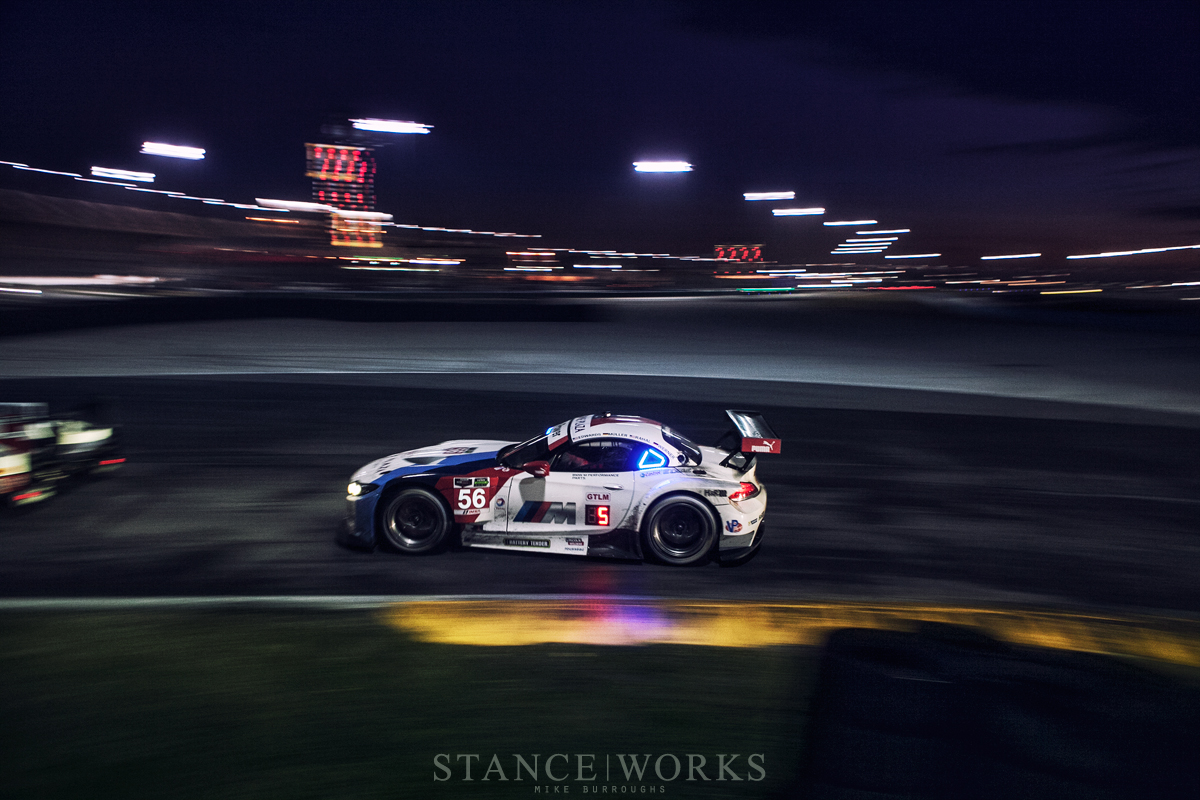
Tiredness had set in hours ago, and it wouldn’t be long before our own 24-hour mark had been passed. We caught brief naps, but it was important not to miss any action. The cars raced in and out of lit areas of the track, and we continuously hoped for something of magnitude to happen. A drastic change in position was on our mind, as we hoped to see BMW move to the front of the pack, but what were the chances? Instead, things remained mostly dormant.
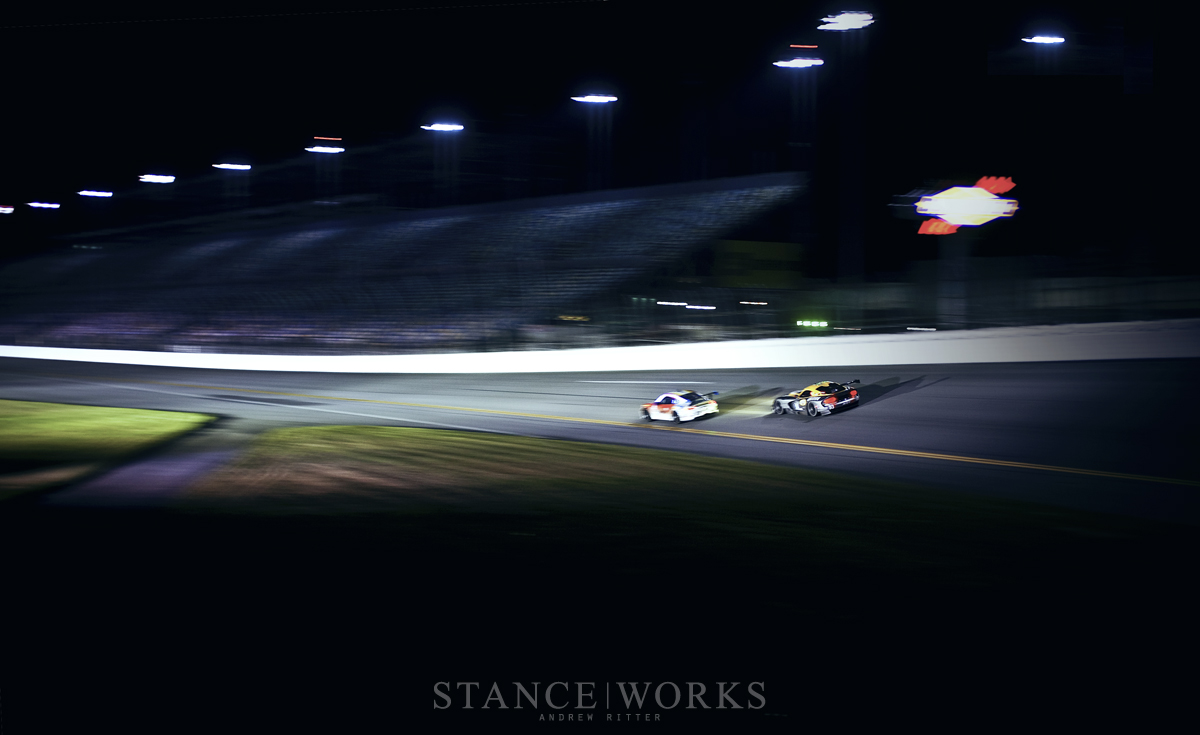
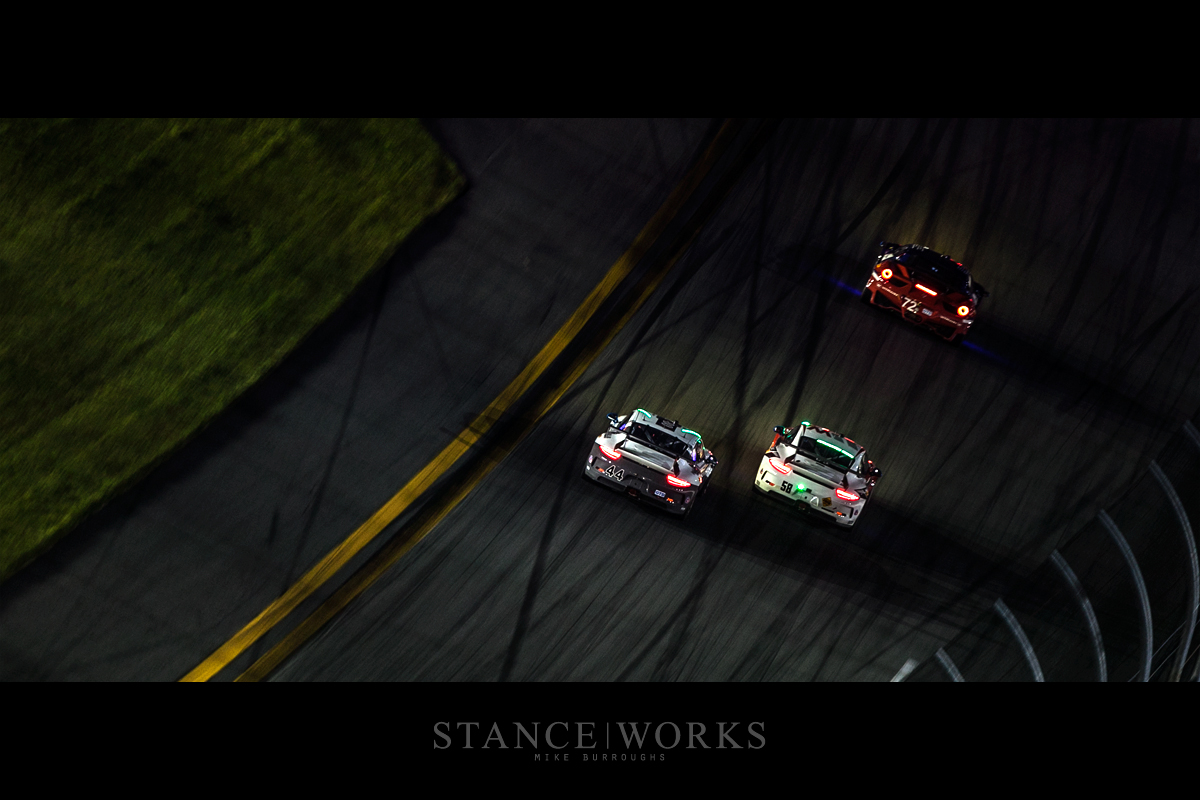
With numb fingers, I sat perched on a berm, anxiously awaiting the sunrise. In the distance, the sky began to glow a deep purple, and then a vibrant crimson and orange. The sky held on to the beautiful gradient only for a short time, before the sun popped up above the horizon and washed the colors away. My shutter fired fast – I couldn’t miss the chance for some of the best lighting of the race.
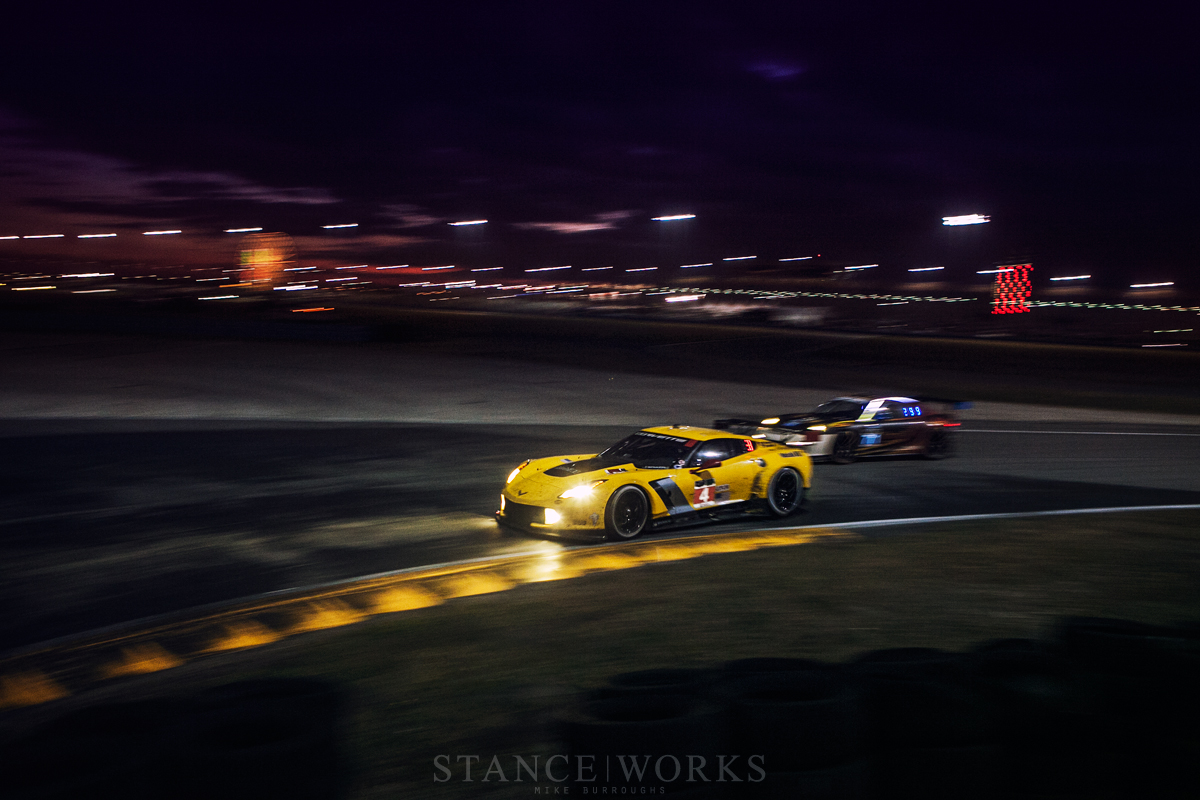
The colors began to fade, and in their place, a deep glow of “sunrise orange” filled the stadium. Much of the field had fallen behind, or fallen off entirely. The Turner Z4 had held its own, with 16 hours under its belt. Turner, too, was earning their keep amongst the best and most enduring.
With the sun working its way higher and higher into the sky, one of the Porsches had suffered an issue, dropping to the back of the pack that remained. The #56 Z4 continued working its way towards the front of the pack, proving that the fable of the “tortoise and the hare” holds true, even when we’re talking about one impressively fast tortoise. The Porsches and Vettes had the upper hand with a slightly-higher top speed, which paid off in a largely high-speed track over the course of a very long time. However, BMW persevered, and worked their way into third place, behind the remaining Porsche and Vette.

However, just as disaster had struck others, it was finally Team RLL’s turn. The #56 car lost precious ground when the right rear wheelbearing failed. The car was hustled to the team’s garage, and we quickly made our way over to capture the fast-paced repair. The crew made quick work of the faulty bearing and control arm, and within what felt like minutes, the car roared back to life. It was rushed back towards the track, where it set back out to earn back precious ground.

What was once a clean field of cars was now caked in rubber, debris, and often tape to hold the front panels together. The cars had suffered the abuse of more than 22 hours of racing. It was Joey Hand’s time to shine as the final driver of the #55 car. The clock was nearing the end of the 24-hour duration, and Joey had slowly worked his way from 5th into 3rd, with last year’s champions in front of him.
After making a valiant pass, Joey moved into second, but the lead of the Porsche meant Team RLL was in need of a miracle to pull off a win. The Gods of Racing heard their pleas, and a yellow caution period allowed Joey to close the gap. The team gathered in the pits to watch the live feed, as the race came down to the wire. BMW had a fighting chance.
In the final laps of the race, with just two minutes to go, Joey had found his way to the rear bumper of the #911 Porsche. My own excitement had me unable to stand still. I wasn’t the only one who knew he had it in him to make the pass – I could feel it in the whole team. Yet, with just moments until the end of the race, a wide-turning Ferrari caused interference amongst the pack, and widened the gap between black and white.
I watched as Porsche crossed the finish line in first place. My heart sank, knowing that with just a few more laps, it could be a win in the books for Team RLL’s first-ever 24-hour race. Experience was with Porsche – they’re the undisputed champions of endurance racing across the globe, and their win of the 52nd-annual Rolex 24 Hours of Daytona was well-deserved.
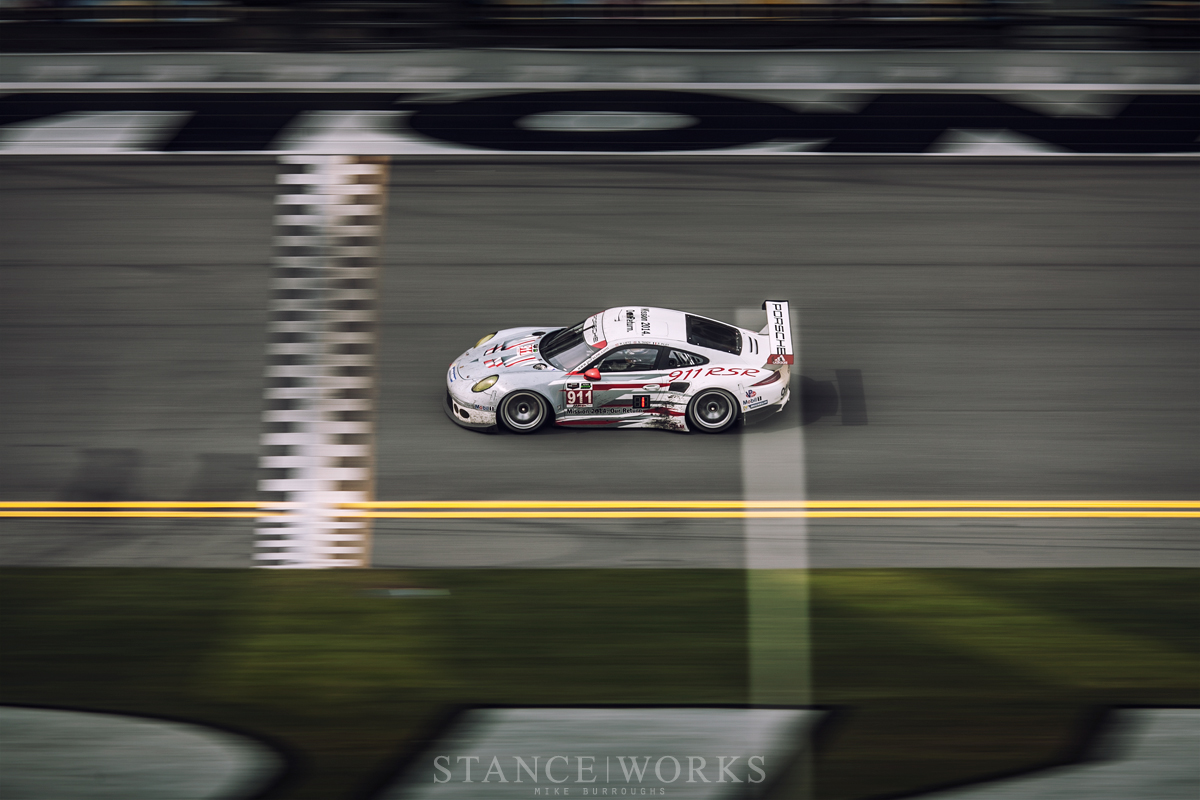
Joey crossed the line just 2.8 seconds behind the Porsche – an under-3-second gap separated first and second place after 24 hours of racing. And better yet, the boys in the #56 car had worked their way back into 4th place, sending Team RLL home with enough points to call the race a success. It was an intense and arguably perfect opening race to the season, and as a first race for an all-new series. If it doesn’t set the tone for the season to come, I don’t know what will. Here’s hoping we see you at Sebring.

